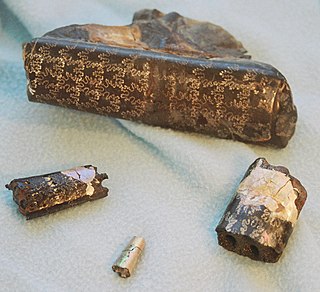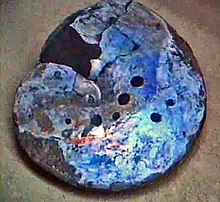
Baculites is an extinct genus of heteromorph ammonite cephalopods with almost straight shells. The genus, which lived worldwide throughout most of the Late Cretaceous, and which briefly survived the K-Pg mass extinction event, was named by Lamarck in 1799.
Huronia is an actinocerid genus included in the Huroniidae along with Discoactinoceras and Huroniella,(Teichert 1964). Huronia is characterized by long siphuncle segments with the free part of the connecting rings only slightly inflated and by a narrow central canal and strongly curved radial canals located in the anterior part of each siphuncle segment
Kamerunoceras is an extinct cephalopod genus belonging to the ammonite family Acanthoceratidae, found in Upper Cretaceous formations of Africa, Europe and North and South America.
Bathmoceras is a primitive cephalopod genus from the Middle and Upper Ordovician. It is a member of the order Cyrtocerinida and is the only genus in the family Bathmoceratidae.

The Actinocerida are an order of generally straight, medium to large cephalopods that lived during the early and middle Paleozoic, distinguished by a siphuncle composed of expanded segments that extend into the adjacent chambers, in which deposits formed within contain a system of radial canals and a narrow space along the inner side of the connecting ring known as a paraspatium. Septal necks are generally short and cyrtochoanitic, some being recumbent, some hook shaped. Most grew to lengths of about 60 to 90 cm but some, like the Huroniidae of the Silurian grew significantly larger.
Baltoceratidae is an extinct family of orthoconic cephalopods belonging to the subclass Nautiloidea endemic to what would be Asia, Australia, Europe, North America, and South America during the Ordovician living from about 480–460 mya, existing for approximately 20 million years.

The Tres Hermanos Formation is a geologic formation in central and west-central New Mexico. It contains fossils characteristic of the Turonian Age of the late Cretaceous.
The genus Cibolaites is a strongly ribbed and nodose ammonoid cephalopod from the middle Cretaceous of western New Mexico, included in the taxonomic family Collignoniceratidae. A single species Cibolaites molenaari is known.

Collignociceras is a strongly ribbed and tuberculate, evolute ammonite from the Turonian of the western U.S. and Europe belonging to the ammonitid family Collignoniceratidae. The genus is named after the French paleontologist Maurice Collignon. The type is Collignoniceras woollgari, named by Mantell in 1822 for specimens from Sussex, England.
Neoptychites is an extinct ammonoid cephalopod genus from the Turonian stage of the Upper Cretaceous, with a worldwide distribution.

Collignoniceratidae is a family of Upper Cretaceous ammonites characterized by typically more or less evolute shells with compressed, oval, or square whorl sections; serrate or entire keels; and dense ribs with one to 5 tubercles.
Morrowites, named by Cobban and Hook, 1983, is a moderate to large-sized ammonite with quadrangular to depressed whorls, broadly rounded to depressed venter, low ribs, umbilical and inner and outer ventrolateral tubercles and smooth early whorls except for occasional ribs along weak constrictions. The suture is moderately simple and has an unusually broad bifid first lateral lobe. It is so far restricted to the Lower Turonian stage, in the mid Cretaceous.

Mammites is a Late Cretaceous ammonite genus included in the acanthoceratoidean family, Acanthoceratidae, and the type genus for the subfamily Mammitinae. Mammites was named by Laube and Bruder in 1887.
The Atarque Sandstone is a geologic formation in New Mexico. It preserves fossils dating back to the late Cretaceous period.
Tragodesmoceras is a large moderately involute ammonite with deeply embracing whorls that are higher than wide, a steep sided umbilicus and a narrowly rounded venter. Ornament consists of primary ribs that begin at the umbilical shoulder and smaller secondary ribs that begin mid flank. Ribs are sigmodal, periodically thickened and bent forward on the outer flank to cross the venter as chevrons. The suture has a broad trifid lateral lobe.
Proplacenticeras is a discoidal ammonite from the lower part of the Upper Cretaceous and precursor of the overall similar Placenticeras.
Cunningtoniceras is a stocky acanthoceratid ammonite from the upper Cenomanian stage of the late Cretaceous of the western U.S., found e.g. in Arizona and New Mexico.
Neocardioceras is a genus of evolute acanthoceratid ammonites from the uppermost Cenomanian, Upper Cretaceous, of Europe, western U.S. and Brazil.
Quitmaniceras is a genus of small, compressed, fairly evolute ammonites from the lower Turonian of Grant County, New Mexico and Trans-Pecos Texas, included in the subfamily Acanthoceratinae. The shell has a carinate venter in juveniles and one that is arched in adults, usually with a raised siphonal line,(siphonal referring to the marginal siphuncle). Ribs are very weak to moderately strong, flexious, typically sloping forward toward the rim, bending further forward at the outer shoulder.

Juana Lopez refers to both the uppermost member of the Carlile Shale formation and to the environment that caused it to form. The Juana Lopez Member is calcareous sandstone dated to the Turonian age of the Upper Cretaceous and is exposed in the southern and western Colorado, northern and central New Mexico, and northeastern Utah. The unit has been described as "the most enigmatic" member of the Carlile Shale.







